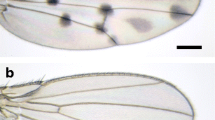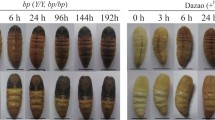Abstract
Like the adult wing, butterfly larvae are unique in their coloring. However, the molecular mechanisms underlying the formation of insect larval color patterns are largely unknown. The larva of the swallowtail butterfly Papilio xuthus changes its color pattern markedly during the 4th ecdysis. We investigated its cuticular color pattern, which is thought to be composed of melanin and related pigments derived from tyrosine. We cloned three enzymes involved in the melanin-synthesis pathway in P. xuthus: tyrosine hydroxylase (TH), dopa decarboxylase (DDC), and ebony. Whole-mount in situ hybridization showed that the expression of both TH and DDC is strongly correlated with the black markings. ebony is strongly expressed only in the reddish-brown area. The expression pattern of each enzyme coincides with the cuticular color pattern of the subsequent instar. We also investigated the uptake of melanin precursors into cultured integument. Inhibition of either TH or DDC activity prevents in vitro pigmentation completely. Addition of dopamine to integuments in the presence of TH inhibitor causes overall darkening without specific markings. From these results, specific larval cuticular color patterns are regulated by stage-specific colocalization of enzymes in epidermal cells rather than by the differential uptake of melanin precursors into individual epidermal cells. Epidermal cells expressing TH and DDC, but not ebony, produce the black cuticle, and epidermal cells expressing TH, DDC, and ebony produce the reddish-brown cuticle.






Similar content being viewed by others
References
Anderson SO (1990) Sclerotization of insect cuticle. In: Ohnishi E, Ishizaki H (eds) Molting and metamorphosis. Japan Scientific Societies Press, Tokyo/Springer Berlin Heidelberg New York, pp 133–155
Fukuda S, Ohnishi E (1971) Transplantation in relation to pigment formation of the integument in the larvae of the swallowtail Papilio xuthus L. Dev Growth Differ 13:279–283
Gompel N, Carroll SB (2003) Genetic mechanisms and constraints governing the evolution of correlated traits in drosophilid flies. Nature 424:931–935
Gompel N, Prud'homme B, Wittkopp PJ, Kassner VA, Carroll SB (2005) Change caught on the wing: cis-regulatory evolution and the origin of pigment patterns in Drosophila. Nature 433:481–487
Grace TDC (1962) Establishment of four strains of cells from insect tissues grown in vitro. Nature 195:788–789
Greene E (1989) A diet-induced developmental polymorphism in a caterpillar. Science 243:643–646
Hearing VJ, Tsukamoto K (1991) Enzymatic control of pigmentation in mammals. FASEB J 5:2902–2909
Hiruma K, Riddiford LM (1985) Hormonal regulation of dopa decarboxylase during a larval molt. Dev Biol 110:509–513
Hiruma K, Riddiford LM (1988) Granular phenoloxidase involved in cuticular melanization in the tobacco hornworm: regulation of its synthesis in the epidermis by juvenile hormone. Dev Biol 130:87–97
Hiruma K, Riddiford LM (1990) Regulation of dopa decarboxylase gene expression in the larval epidermis of the tobacco hornworm by 20-hydroxyecdysone and juvenile hormone. Dev Biol 138:214–224
Hiruma K, Riddiford LM, Hopkins TL, Morgan TD (1985) Roles of dopa decarboxylase and phenoloxidase in the melanization of tobacco hornworm and their control by 20-hydroxyecdysone. J Comp Physiol B 155:659–669
Hopkins TL, Morgan TD, Kramer KJ (1984) Catecholamines in hemolymph and cuticle during larval, pupal and adult development of Manduca sexta (L.). Insect Biochem 14:533–540
Hori M, Hiruma K, Riddiford LM (1984) Cuticular melanization in the tobacco hornworm larva. Insect Biochem 14:267–274
Kiguchi K, Agui N (1981) Ecdysteroid levels and developmental events during larval moulting in the silk worm, Bombyx mori. J Insect Physiol 27:805–812
Koch PB, Keys DN, Rocheleau T, Aronstein K, Blackburn M, Carroll SB, ffrench-Constant RH (1998) Regulation of dopa decarboxylase expression during color pattern formation in wild-type and melanic tiger swallowtail butterflies. Development 125:2303–2313
Koch PB, Bechnecke B, ffrench-Constant RH (2000) The molecular basis of melanism and mimicry in a swallowtail butterfly. Curr Biol 10:591–594
Kopp A, Duncan I (1997) Control of cell fate and polarity in the adult abdominal segments of Drosophila by optomotor-blind. Development 124:3715–3726
Kopp A, Duncan I, Godt D, Carroll SB (2000) Genetic control and evolution of sexually dimorphic characters in Drosophila. Nature 408:553–559
Kramer KJ, Hopkins TL (1987) Tyrosine metabolism for insect cuticle tanning. Arch Insect Biochem Physiol 6:279–301
Kumar S, Tamura K, Jakobsen IB, Nei M (2001) MEGA2: molecular evolutionary genetics analysis software. Bioinformatics 17:1244–1245
Nijhout HF, Wheeler DE (1982) Juvenile hormone and the physiological basis of insect polymorphism. Q Rev Biol 57:109–133
Scoble MJ (1992) The lepidoptera. Oxford University Press, New York
Thompson JD, Gibson TJ, Plewniak F, Jeanmougin F, Higgins DG (1997) The CLUSTAL_X windows interface: flexible strategies for multiple sequence alignment aided by quality analysis tools. Nucleic Acids Res 25:4876–4882
True JR, Edwards KA, Yamamoto D, Carroll SB (1999) Drosophila wing melanin patterns from by vein-dependent elaboration of enzymatic prepatterns. Curr Biol 9:1382–1391
Truman JW, Riddiford LM, Safranek L (1973) Hormonal control of cuticle coloration in the tobacco hornworm: basis of an ultrasensitive assay for juvenile hormone. J Insect Physiol 19:195–204
Vie A, Cigna M, Toci R, Birman S (1999) Differential regulation of Drosophila tyrosine hydroxylase isoforms by dopamine binding and cAMP-dependent phosphorylation. J Biol Chem 274:16788–16795
Wittkopp PJ, True JR, Carroll SB (2002a) Reciprocal functions of the Drosophila yellow and ebony proteins in the development and evolution of pigment patterns. Development 129:1849–1858
Wittkopp PJ, Vaccaro K, Carroll SB (2002b) Evolution of yellow gene regulation and pigmentation in drosophila. Curr Biol 12:1547–1556
Wittkopp PJ, Williams BL, Selegue JE, Carroll SB (2003a) Drosophila pigmentation evolution: divergent genotypes underlying convergent phenotypes. Proc Natl Acad Sci U S A 100:1808–1813
Wittkopp PJ, Carroll SB, Kopp A (2003b) Evolution in black and white: genetic control of pigment patterns in Drosophila. Trends Genet 19:495–504
Wright TRF (1987) The genetics of biogenic amine metabolism, sclerotization, and melanization in Drosophila melanogaster. Adv Genet 24:127–222
Yamanaka A, Ito T, Koga D, Sato T, Ochiai M, Endo K (2000) Purification and characterization of biliverdin-binding protein from larval hemolymph of the swallowtail butterfly, Papilio xuthus L. Biosci Biotechnol Biochem 64:1978–1981
Acknowledgements
This work was supported by grants from the Ministry of Education, Science, and Culture of Japan and Research Fellowship of Japan Society for the Promotion of Science for Young Scientists. We are very grateful to Dr. A. Yamanaka for kindly providing many larvae of P. xuthus. We would like to thank Drs. R. Niwa and S. Fukamachi for comments on the manuscript and Mrs. S. Okamoto, S. Nakaya and Dr. Y. Iimura for technical advice.
Author information
Authors and Affiliations
Corresponding author
Additional information
Communicated by S. Roth
Rights and permissions
About this article
Cite this article
Futahashi, R., Fujiwara, H. Melanin-synthesis enzymes coregulate stage-specific larval cuticular markings in the swallowtail butterfly, Papilio xuthus . Dev Genes Evol 215, 519–529 (2005). https://doi.org/10.1007/s00427-005-0014-y
Received:
Accepted:
Published:
Issue Date:
DOI: https://doi.org/10.1007/s00427-005-0014-y




